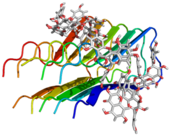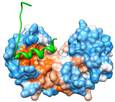Highlight
Molecular dynamic simulations to understand therapeutics for neurological disorders
Achievement/Results
NSF-funded Professor David Bevan and MILES IGERT trainees Justin Lemkul and William Allen in the Biochemistry department are continuing their investigations and using cutting-edge molecular simulations to help develop natural therapeutics for neurological diseases (Parkinson’s and Alzheimer’s). The researchers are using a technique called molecular dynamics (MD) simulations to search for proteins, enzymes, and small molecules with antioxidant activities.
Justin Lemkul is using molecular simulations to explore how compounds present in red wine may work to prevent and reverse the microscopic events that give rise to Alzheimer’s disease. While epidemiological data have long suggested that the antioxidant molecules in red wine have positive health benefits in many diseases, many questions remain regarding the exact mechanism through which they act. Experiments have shown that the unfolding and aggregation of the amyloid B-peptide (AB) kills neurons, leading to Alzheimer’s disease, making this protein a target for therapeutic intervention. In vitro work has concluded that a class of compounds present in red wine, known as flavonoids, can break up the AB protein aggregates, but the mechanism for this phenomenon remains unclear. Molecular dynamics (MD) simulations are being used to explore the nature of the AB-flavonoid interactions, providing a level of detail that is inaccessible to most experimental techniques.
Dr. Bevan’s group recently shown that morin, a type of flavonoid, can bind to the surface of AB aggregates (shown below) to block further aggregation. Furthermore, if morin penetrates inside the AB aggregates, it can disrupt the normal interactions between the protein molecules. The results of these simulations have indicated key chemical features present in morin and other flavonoids that may be useful in drug design for novel therapeutics to treat Alzheimer’s disease.
William Allen has continued studying monoamine oxidase B (an enzyme that has been implicated in Parkinson’s disease) using molecular modeling techniques to identify and characterize the specific interactions that lead to inhibitor recognition, binding, and affinity. In addition, William Allen and Prof. David Bevan have discovered several important interactions between the tumor suppressor protein p53 and several regulatory proteins. These fundamental interactions are important because their disruption by means of short peptide or small molecule therapeutics could potentially restore p53 function in damaged cells, a function that is necessary in cancer prevention. The specific interactions include a pattern of hydrogen-bonding behavior between the p53 C-terminal domain and a hydrophobic patch on each receptor protein. With the information gathered in this study, the next logical step is to design and test therapeutics that target the same hydrophobic patch, behaving and binding similarly to the p53 C-terminal domain when it binds. The successful design of such therapeutics would result in free p53 in the cell, allowing it to resume its normal role as a tumor suppressor protein.
Address Goals
These investigations are important because the mechanisms for these neurological degenerative diseases are unknown, and the molecular simulations provide atomic-level detail that is impossible to achieve with current experimental methods. The contributions of this work extend primarily to the pharmaceutical industry, but also to the fundamental understanding of the progressive events of Alzheimer’s and Parkinson’s diseases. P53 is a tumor suppressor protein. In 50% of cancer cases, p53 is not working correctly in the cell. The general consensus is that restoration of p53 function in aberrantly growing cells is of enormous therapeutic benefit. Better understanding of these interactions can lead to designing competitive inhibitors for the p53 binding sites, identifying novel receptor proteins, or identifying the p53 binding site on previously defined receptor proteins.







